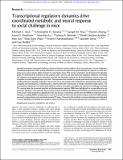Transcriptional regulatory dynamics drive coordinated metabolic and neural response to social challenge in mice
Author(s)
Saul, Michael C.; Seward, Christopher H.; Troy, Joseph M.; Zhang, Huimin; Sloofman, Laura G.; Lu, Xiaochen; Weisner, Patricia A.; Caetano-Anolles, Derek; Sun, Hao; Zhao, Sihai Dave; Sinha, Saurabh; Stubbs, Lisa; Chandrasekaran, Sriram; ... Show more Show less
DownloadGenome Res.-2017-Saul-959-72.pdf (1.623Mb)
PUBLISHER_CC
Publisher with Creative Commons License
Creative Commons Attribution
Terms of use
Metadata
Show full item recordAbstract
Agonistic encounters are powerful effectors of future behavior, and the ability to learn from this type of social challenge is an essential adaptive trait. We recently identified a conserved transcriptional program defining the response to social challenge across animal species, highly enriched in transcription factor (TF), energy metabolism, and developmental signaling genes. To understand the trajectory of this program and to uncover the most important regulatory influences controlling this response, we integrated gene expression data with the chromatin landscape in the hypothalamus, frontal cortex, and amygdala of socially challenged mice over time. The expression data revealed a complex spatiotemporal patterning of events starting with neural signaling molecules in the frontal cortex and ending in the modulation of developmental factors in the amygdala and hypothalamus, underpinned by a systems-wide shift in expression of energy metabolism-related genes. The transcriptional signals were correlated with significant shifts in chromatin accessibility and a network of challenge-associated TFs. Among these, the conserved metabolic and developmental regulator ESRRA was highlighted for an especially early and important regulatory role. Cell-type deconvolution analysis attributed the differential metabolic and developmental signals in this social context primarily to oligodendrocytes and neurons, respectively, and we show that ESRRA is expressed in both cell types. Localizing ESRRA binding sites in cortical chromatin, we show that this nuclear receptor binds both differentially expressed energy-related and neurodevelopmental TF genes. These data link metabolic and neurodevelopmental signali ng to social challenge, and identify key regulatory drivers of this process with unprecedented tissue and temporal resolution.
Date issued
2017-03Department
Massachusetts Institute of Technology. Institute for Medical Engineering & Science; Broad Institute of MIT and HarvardJournal
Genome Research
Publisher
Cold Spring Harbor Laboratory Press
Citation
Saul, Michael C. et al. “Transcriptional Regulatory Dynamics Drive Coordinated Metabolic and Neural Response to Social Challenge in Mice.” Genome Research 27, 6 (March 2017): 959–972 © 2017 Saul et al
Version: Final published version
ISSN
1088-9051
1549-5469
